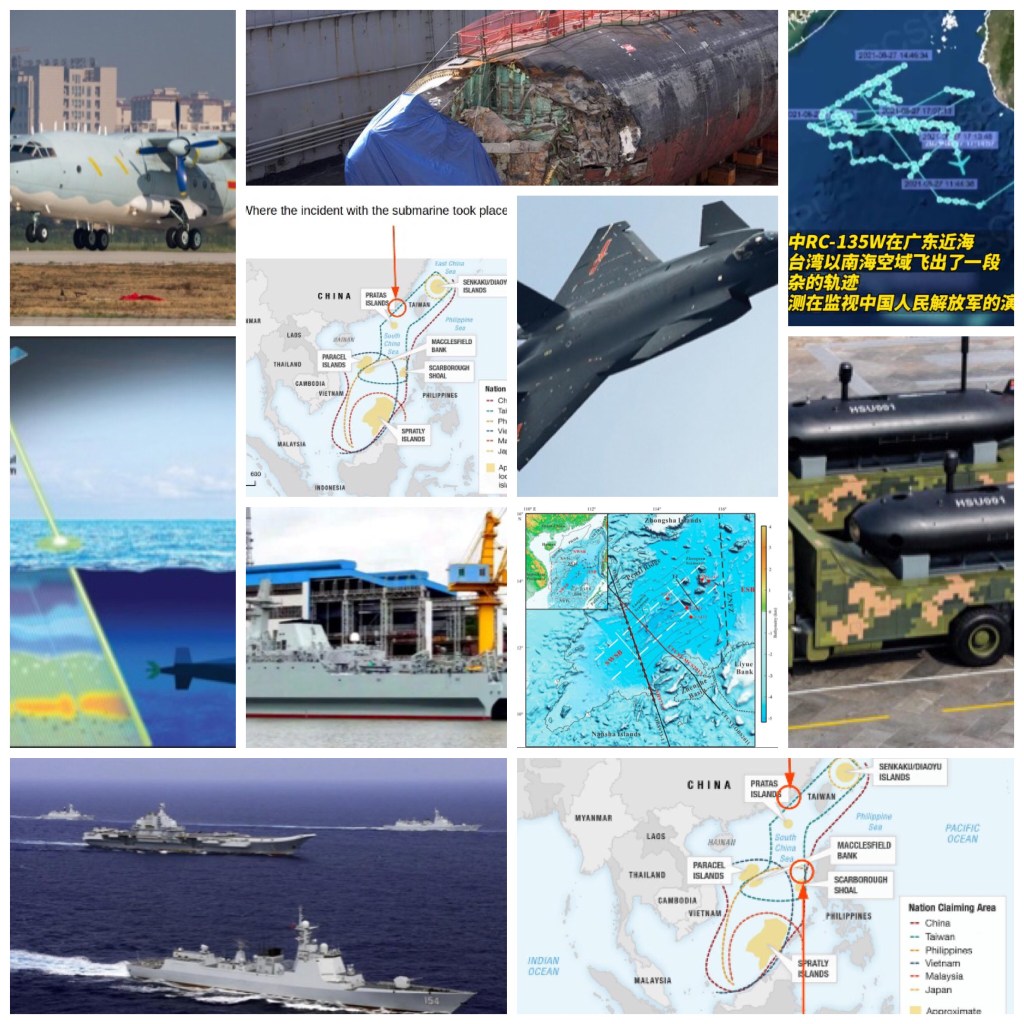
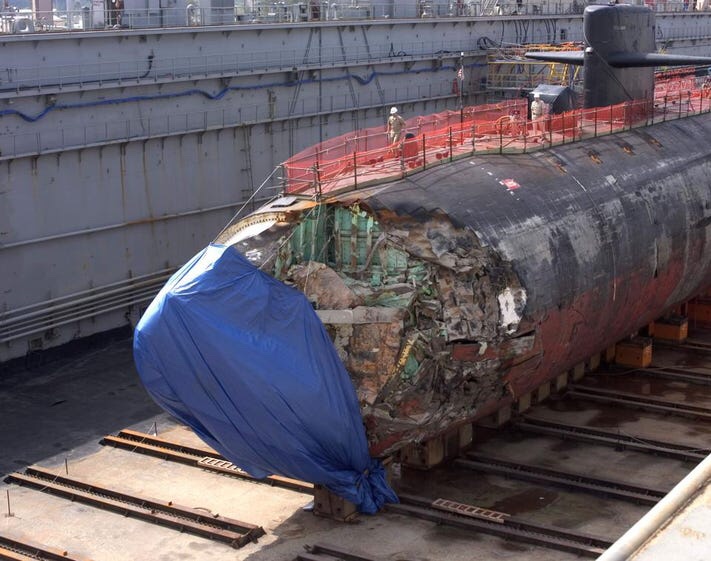
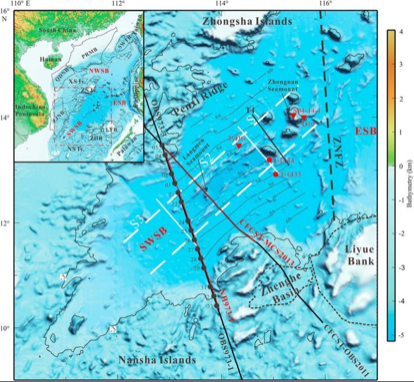
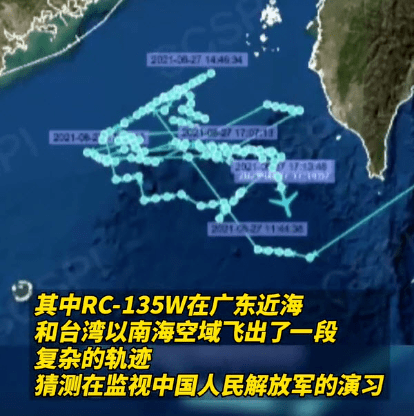
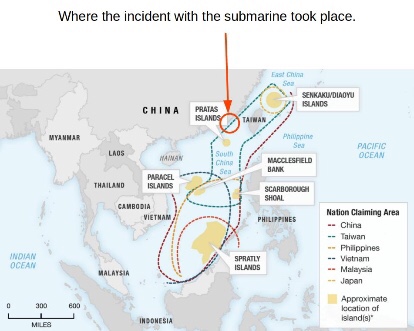







What really happened to USS Connecticut? US said hit an undersea mountain and Unconfirmed Source from China said otherwise, you be the judge.
According to this article, China punched USS Connecticut literally on the nose and figuratively a bloody nose for Uncle Sam. I happened to have lunch with someone from Beijing today and I asked him as to the authenticity of this China side of the story on what happened to the submarine. He said this Chinese version is as “unofficially official” story you’ll get.
Drone story on USS Connecticut. Try https://metallicman.com/USS-connecticut-black-operations-submarine-south-china-sea-ram-mountain-what-really-happened/
What REALLY happened with the collision of the USS Connecticut in the South China Sea
The official American story is that the USS Connecticut rammed into an unmarked undersea mountain.
Since the Navy revealed this week that the fast-attack submarine Connecticut struck an undersea mountain in early October while operating in the South China Sea, one question springs to mind: how could this happen?
How could a $3 billion Seawolf-class boat, considered one of the Navy’s most formidable and advanced, crash into an undersea landmass?
-NavyTimes
Which is pretty strange as the locations of all undersea mountains has been well mapped for decades. You can see them on Google Earth for goodness sakes!
It’s a very questionable conclusion.
And you know, what makes it even more questionable is that the United States navy has been flying their radiation detection aircraft all over where the USS Connecticut was running operations. Which is abnormal.
Radiation detection aircraft flight path…
But then if you couple the United States silence to the Chinese inquiries as to whether or not nuclear payloads, equipment, and fissionable materials entered Chinese waters.
There are absolutely zero answers from the United States government to very serious questions asked by China.
The official Chinese story is something else. Here we will tell the Chinese side of the story.
Believe it or not. It’s up to you.
Here’s another post that you simply will not find anywhere else on the Internet. And, you know, I tire of my own sluggishness in trying to understand the great failure of the American “free media”.
Even I realize that there is no such thing as actual “news” in the West, but really guys it’s not too FUCKING DIFFICULT.
Beware of any “news” that you WANT to believe.
Look for what IS NOT being reported in the mainstream or conservative media.
Take particular note when the official narrative is absurd.
Be especially cautious of “seeded“ narratives that you get in emails, or in alternative websites.
That being said, let’s dive in…
From my email 17NOV21
I had a little message from one of my friends regarding the Connecticut incident. FYI, it seems the following message was approved by Beijing so I will just tack it on here. It has been translated from Chinese, with some clarifications to the machine translations by MM.
…
The Chinese military authorizes the disclosure of the truth about the accident of the Seawolf class nuclear submarine on the USS Connecticut.
16 November 2021
How the Chinese People’s Liberation Army hunted and sunk the (state of the art) USS Connecticut Seawolf-class attack nuclear submarine in the South China Sea.
-October 2-
The British aircraft carrier Queen Elizabeth, the American aircraft carrier Nimitz, the American aircraft carrier Roosevelt, and the Japanese aircraft carrier Izumo entered Chinese waters. It dis so with 17 other warships. They hailed from the United States, Britain, Japan, the Netherlands, Canada and Australia. This 4 aircraft carrier armada represented the Western power of six nations.
.
The South China Sea armada begins to conduct large-scale military exercises against China. This was done off the Chinese coast and within Chinese territorial waters.
October 2 to 4-
The People’s Liberation Army dispatched a large number of military aircraft to the South China Sea to conduct simulated attack exercises against these uninvited warships. The armada came from six countries. they were the United States, Britain, Japan, Holland, Canada and Australia.
October 2-
China’s Guanlan Marine Science Guard observed the approximate position and depth of the USS Connnecticut Seawolf class nuclear submarine when it entered the South China Sea. It followed it as it approached the South China Sea, and conducted operations South of Taiwan. It then observed it creep up the coast and operated near the Chinese shoreline and conduct surreptitious and illegal operations (inside of Chinese territorial waters as defined by the UN) of an unknown nature.
.
The Guanlan satellite sent the data to the Super Measurement Center in Jinan to estimate the position of the Connecticut.
China’s special detection device captured the ultra-low frequency sonar from the bow of the Connecticut spherical boat and transmitted the data to the Sonar Analysis Center in Shanghai to accurately locate the position and depth of the Connecticut. It was operating at 1500 meters [?] making and conducting obvious operations and drills inside of the Chinese coastline.
-The Type 927 underwater acoustic detection ship stationed on Yongshou Island and the anti-submarine helicopter stationed on Yongxing Island are dispatched for detection.
The Yun-8 military plane took off from the Hainan Air Force Base and carried out a “sonic bomb” on the Connecticut.
.
This technology (a “sonic bomb”) causes the submarine’s personnel to be extremely uncomfortable due to the sonic shock. It does not injure or kill anyone. It simply makes all their pain receptors ignite on their bodies.
.
This terror and discomfort forced the submarine to try to escape from the targeting cone of effect.
While it was trying to exit the cone of effect, the AI controlled robotic Chinese HSU001 unmanned submarine slipped silently to the nuclear submarine Connecticut. Where it attached itself to the bow of the ship.
.
This was an intentional placement. This locations was as far away as possible from the nuclear power plant for a close local directed-explosion attack.
.
It was then ignited, and ended up causing serious damage to the bow of the boat and a complete loss of sonar sensing ability.
.
The navigation capabilities and the nuclear power plants were not affected, preventing nuclear leaks from polluting the fishing waters off the Chinese coast.
The Connecticut nuclear submarine, which lost its underwater submarine capability, was forced to float up and surrender. As it broke the surface, it was met with Chinese PLA Naval vessels who took no overt action.
.
Due to the close surveillance of the navy and air force of the Chinese People’s Liberation Army, military aircraft and ships from the six countries of the United States, Japan, Britain, Australia, Holland, and Canada dared not come to rescue the submarine in the South China Sea exercise.
.
The Chinese military forced the submarine to float up and surrender.”
The submarine was “escorted” by the Chinese Navy and Air Force while in the South China Sea and the submarine was directed to follow the ships to docking facilities on the Chinese mainland.
.
Where it then again submerged. Further contact with the submarine was then lost.
-October 7th-
The United States announced the Connecticut accident by the United States.
-October 7-
The Chinese Foreign Ministry frantically questioned the ins and outs of the USS Connecticut incident to the Biden administration, but did not obtain any answers or explanations.
-October 22-
The Chinese monitoring system detected a US nuclear submarine entering the South China Sea again near Huangyan Island.
A final update by the source
The PLAN would be messing around with USN at this point.
1500 meter depth misinfo probably planted deliberately to taunt them because if the Drone sub did find the Connecticut, they definitely knew the actual depth it was running.
From the questions subsequently posed by the Chinese, it does seem they knew there was no nuclear leak.
China is playing around but It’s like a cat with a mouse it caught.
The whole thing has Donald Cook vibes. Morale can’t be good atm.
Added youtu.be link. You might like. https://youtu.be/VeJLwUfLcEU.
Conclusions
Interesting version of events. This certainly makes far more sense that “accidentally” hit an “unmarked mountain”. But whether or not it is actually true is unknown and will stay that way forever.
.
So, I do not know how true it is. We must always be aware of propaganda consisting of what we want to believe. The aspects of this particular narrative that makes sense is that it is in alignment with current Chinese technology and military doctrine.
.
It is obvious that the Chinese do not want radioactive waters near the Chinese coast, so they only damaged the sub, not sunk it completely. For after all it is a nuclear sub carrying nuclear torpedoes. But we cannot expect this behavior and “safety rules” to continue with the pushing by the United States towards war. This is an aspect of war that I hadn’t thought about previously, but makes complete sense. This is why New Zealand absolutely refuses any nuclear vessels in and near it’s waters.
.
I presume there is video footage of the sub surfacing and it’s surrender. The PLA Navy seem to be toying around with the US navy like a cat would with a mouse. Seeing this video footage would greatly substantiate this narrative, but as in all things Chinese PLA, access and dissemination are tightly controlled.
.
It’s difficult for me to accept the American narrative that the submarine not only collided with an uncharted mountain, but that the Chinese just stood by and did nothing while a four aircraft carrier armada conducted missile drills simulating an attack on China. There are NO uncharted undersea mountains in the South China Sea. Hasn’t anyone watched the 1980’s Tom Clancy movie “Red October”? The entire ocean has been mapped.
.
It is also difficult for me to believe that the Chinese with all their advances and lead in military technology are thwarted by the American Navy. It just doesn’t stand up to the “sniff test”. At least not to us “technology wonks“.
.
True or not, you can rest assured that this release of this information would have been war gamed and factored into the AI computations that will figure predominantly in the events of the future.
.
If the provocations continue, we can expect China to sink the submarines completely. The impression that I have is that they are “being gentle” at this moment in time. Let’s see what happens next.
.
Interesting read never the less.
Despite a virtual news blackout, information on America’s damaged Seawolf Class attack submarine, USS Connecticut (SSN-22), is starting to leak out. While details are scarce, the Pacific Fleet’s latest operational debacle has left the U.S. without a key undersea combatant. At a minimum, the USS Connecticut will be out of service for years, and there is a creeping realization that the damage may be significant enough to force the USS Connecticut into a premature retirement.
It is time for the Navy to start talking. Regardless of the outcome, the fate of the USS Connecticut has enormous ramifications for virtually every facet of America’s maritime industrial base. Given the extended news blackout and the fact that the submarine hasn’t budged from Guam yet, indications suggest the USS Connecticut is badly hurt.
This is no time to smother a potentially uncomfortable debate under an over-classified blanket; the USS Connecticut’s mishap is a big deal and no longer a cozy internal Navy matter.
With the Command Investigation nearing completion, the Navy’s continued silence is doing more harm than good. China is gleefully hammering away at America’s sullen silence. And every day spent keeping the USS Connecticut under wraps is one less day for America to debate and prepare a viable path forward. Geopolitics aside, the United States needs to know just how the USS Connecticut’s accident is likely to stress America’s undersea industrial base. And if this mishap is a self-inflicted wound, stemming from longstanding but long-unfixed problems within the Navy, then real changes must be made.
There is no more time for the Navy to indulge in a long, leisurely study into root causes before deciding on the way ahead. Somebody, somewhere in the Navy Department needs to take what data is available today and use it to lead. Decisions on the stricken sub need to be made quickly, dispassionately, and with a rigor that an emotional Navy will be loathe to deliver.
This crisis is now the defining challenge for Carlos Del Toro, the new Navy Secretary. America can only hope he is stern enough for the task ahead.
It Doesn’t Sound Good
While the “silent service” is living up to its name, information on the submarine’s condition is gradually leaking out. Over at the U.S. Naval Institute (USNI), the indefatigable Sam LaGrone is hearing whispers of damage. Two defense officials told USNI that the impact “damaged the submarine’s forward ballast tanks.” Others told USNI News that the submarine had hit and grounded upon an uncharted seamount in the South China Sea.
The last time the Navy publicly reported a submarine had damaged their forward ballast tanks was in 2005, when the USS San Francisco (SSN-711) suffered a catastrophic collision with a seamount. While nobody is saying that the USS Connecticut suffered as extensive damage in the current incident, the USS Connecticut likely won’t be returning to service anytime soon.
Submarine repairs take a lot of time. The USS San Francisco was stuck at Guam for seven months and needed four years of work before returning to service.
To get the USS San Francisco’s back in a timely fashion, the Navy resorted to cannibalism, taking a bow from the retiring USS Honolulu (SSN-718)—a similarly-aged sub that, due to budget cuts, was being prematurely retired. The “nose job” was complex enough, requiring 285,000 worker days to complete, but the task of appropriating the old bow and aligning and mating internal systems was a whole lot easier than repairing and restoring damaged external hull structures from scratch.
Working from scratch is what the Navy will likely need to do if it wants to repair the USS Connecticut. As the Navy has little in the way of spare Seawolf Class parts sitting around—and no older boats to cannibalize—rehabilitating and re-certifying the USS Connecticut may be a far more time-consuming and expensive engineering challenge than either the U.S. Navy or U.S. taxpayers expect.
In these situations, the Navy’s instinctual bias is almost always slanted towards saving the damaged craft—regardless of whether it makes fiscal or operational sense. In the USS San Francisco’s case, the Navy had two obvious options—either repair the newly-refueled USS San Francisco or retire the USS San Francisco and refuel a similarly—aged submarine, USS Honolulu. To support the decision the Navy estimated that the repairs would cost $79 million, about half the $170 million needed to refuel the Honolulu. But the Navy’s initial repair estimate was inaccurate, and the fix became a relative “wash,” with the final bill for the USS San Francisco clocking in at $134 million—barely a 20% difference.
Neither option is available today—the choice is either to retire the sub or try to fix it. But again, the bias will be towards saving the sub. For the Navy, the political cost of losing the USS Connecticut will be enormous, and, frankly, Congress may expect naval leadership—from the Chief of Naval Operations on down—to pay for it with their careers. But with few spares and no prior hulls to cannibalize, repairing the USS Connecticut risks becoming a complex, sprawling affair that the Navy simply cannot afford to endure. There are no good options.
Is the Juice Worth The Squeeze?
Depending upon the damage, retiring the USS Connecticut early and turning it into a “parts barn” for the USS Seawolf (SSN-21) and USS Jimmy Carter (SSN-23) may well be the only sensible path.
The USS Connecticut is a unique “Cold War” fighter, endowed with enviable capabilities, but it is—to put it bluntly—also a middle-aged representative of a boutique and hard-to-maintain three-submarine class. Presently 23 years old, and with an expected service life of about 40 years, a pricey, four to five-year availability may not be worth the total cost—not just in repair dollars necessary for the USS Connecticut itself, but in the toll deferred maintenance on other platforms will inflict upon the rest of the Navy.
Time is the enemy here. Submarines have a finite lifespan. In the case of the USS San Francisco, the years spent inactive in the repair yard didn’t translate into extra service life. The USS San Francisco ultimately retired after 40 years while the submarine’s undamaged but similarly-aged peers left the service at 38 years.
The same will be true with the USS Connecticut. Even if repaired, the USS Connecticut may emerge with numerous operational restrictions and only enough formal service life to offer America a mere handful of patrols. The long refit may leave the sub’s reactor with an enormous amount of energy left to offer, but, to leverage that power, the USS Connecticut’s hull and associated structures would need very thorough—and expensive—analyses to keep the boat safe and certified for operations. Once operational, added maintenance and safety checks would eat away the boat’s remaining time forward.
Again, the unique nature of the Seawolf Class—a thicker hull built with harder steel—is a problem. The Navy’s 62 Los Angeles Class attack submarines offered numerous opportunities to harvest condition-related data collection and conduct hull performance studies. But the three Seawolf boats (and a few Los Angeles Class subs that trialed the high-strength steel) just cannot generate the necessary data in an efficient fashion.
It is unfortunate that the USS Connecticut suffered the maritime equivalent of a controlled flight into terrain after being, in effect, conserved for just the type of challenge China presents. But the faster the Navy and Congress realize that the USS Connecticut, if repaired, will never be a true Seawolf again, the faster America can move forward—either by buying more subs, accelerating the development of a new attack submarine design or by repairing the USS Connecticut and shunting it into a less demanding support role, serving as, say, a battery pack and test platform for undersea systems.
The Navy Is At Crush Depth
Deciding the fate of the USS San Francisco was hard enough. But this time, with the USS Connecticut, the trade-offs will be far tougher to map out. The strategic challenge with China, coupled with the Navy’s fiscal, operational, and maintenance crises at home make the path forward far more challenging.
But this is where Del Toro can make a difference. It is the Secretary of the Navy’s job to hold the institution’s feet to the fire, and Congress has empowered Del Toro to make hard decisions on accountability and on the way forward. Hopefully he is up to the task.